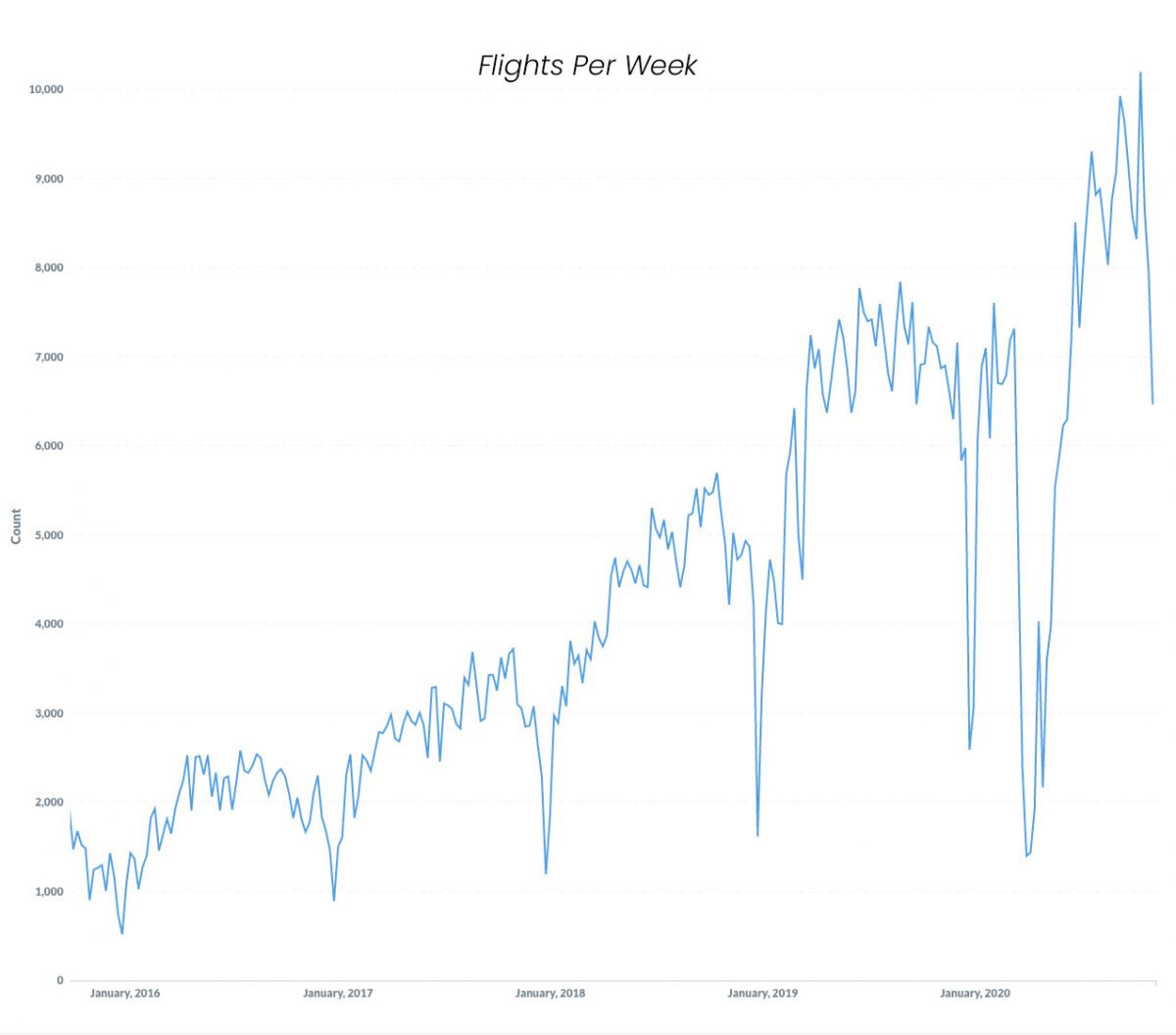Since Covid-19 hit us early this year, experts from the aviation industry have made predictions on its impact on the demand for new pilots worldwide, and thereby also on the activity level, that pilot training organizations should expect for the coming years. Most of these have naturally been based on assumptions on how the need for pilots will develop in the years to come.
To offer some evidence-based input to this discussion, FlightLogger has decided to share some unique insights on the actual current activity level in the pilot training industry based on statistical data collected before and during the pandemic.
(The statistics used for this article is based on data collected by FlightLogger from more than 45,000 users in 110+ ab initio pilot academies worldwide)
Recently, German Lufthansa went as far as recommending pilot students to seek other career opportunities, stating that they expect no need for new pilots for a foreseeable future. Others, like Bhanu Choudhrie from Alpha Aviation Group, are much more positive and claim that airlines will have to start recruiting again within two years, which means student pilots starting now could expect to be in demand, when they graduate in two years’ time. Luckily, the amount of positive predictions is growing, this recent pilot outlook from CAE being a great example.
We will not be making any predictions about the future need for pilots. Instead, we will take a look at the development of pilot training activities in ab initio training organizations since Covid-19 hit us.
With live data from currently 111 variously sized pilot academies across 40 countries worldwide, we have been following the development of pilot academy training activities closely for several years – and with increased interest during this last year. We see some very clear tendencies that we would like to share with the industry in order to put a light on how the pilot training industry is actually coping with the crisis.
Data shows pilot training took severe hit from Covid-19 but is in recovery
A very interesting statistic to look at is the average number of active pilot students per pilot academy. In FlightLogger, the term active students means students that are progressing through any sort of pilot training program and marked as being active by their academy. This data is collected by FlightLogger since our pricing model charges for active students only, so the academies are saving money by putting inactive students on “standby”.
Looking at the graph below, the average number of active students on academies managed with FlightLogger has been steadily growing – in fact, almost doubling from 2016 and until March 2020 (mainly due to the fact that our existing customers have grown while using our platform since 2016).
In March, when Covid-19 hit worldwide, training activities took a severe dive, which was a direct effect of entire countries being completely or partly closed down. In April, the worst month statistically, activities were down to approximately 60 percent of the level we saw before Covid-19 (in fact, the decline started mid-March but looking at monthly stats somewhat conceals this).

However, already from May, our data started to show a gradual recovery, which has sustained until September, where the average number of active students per academy seems to have stabilized. Note that the graph shown here is based on monthly data, but our internal daily reports confirm this stagnation in activity from early September. Based on these statistics, the average pilot academy is currently back at approximately 94 percent of the pre-Covid-19 activity level, measured by this parameter.
This is of course an overall view of how it’s going. Looking at individual academies, we know for a fact that some have been hit hard and have lost as much as 40-60 percent of their activities, while others have practically not been affected by Covid-19.
Data on school flight activity confirms the trend of recovery and stagnation
Looking at another important parameter, the weekly number of school flights registered in total, we see a very similar pattern. There’s a strong growth all the way from 2016 and until Covid-19 hit us (the growth looks a bit more dramatic, in part because the number of schools using FlightLogger has increased in this period).
The graph below clearly shows a similar drop in activity starting from mid-March and hitting a low at the beginning of April, where it was down to just 19 percent of the activity just a month before. Then in May, the recovery accelerates and in mid-June, school flight activities actually reach a record-high number and continues to grow steadily until the beginning of October, where we exceed 10,000 weekly flights for the first time. We expect that part of this increase is also due to students who have been delayed in their education and now are “catching up”.
In line with the first graph shown, we again see a decrease in activity in October. Looking at this, it is important to note that this decrease follows a clear pattern also seen the previous years, which means it’s probably not primarily related to Covid-19. The explanation for this yearly trend is partly that a vast majority of the 111 schools are placed in the northern hemisphere, where school flight activity is typically lower during the winter months, and partly that we see many schools who have students that complete their training during these months.

Current status and predictions for the coming months
All in all, the two data sets document a similar tendency of a sudden fall in activity followed up by a rather quick recovery. Again, this is when looking at the average school. When looking at individual schools, things can look quite different.
Measured by the number of average students per school (which is what we consider the strongest way pointer for the actual development), the average pilot academy is currently back at approximately 94 percent of the pre-corona activity level, which is quite surprising in a very positive sense.
However, the stagnation and slight fall in activity from September to October could be the first sign of reactions to a second wave of Covid-19. This corresponds with our expectations of a slight worsening of the activity level during the upcoming winter (Northern hemisphere), due to the restrictions we already see reinstated in most countries – and of course also due to the general uncertainty caused by the pandemic. And it corresponds also with an expectation of further worsening if intake of new students does not match the amount of delayed students finishing their pilot education.
New data will be released monthly
However, rather than making too many assumptions we will continue to look at our unique statistics and provide a monthly update with updated data from our pilot academies for as long as we find it relevant to follow. So, if you would like us to include other statistics, feel free to contact our marketing manager Mads D. Larsen by sending an email to [email protected].
To keep you updated, we will continuously update our insights via our blog, so feel free to add flightlogger.net/blog to your browser favorites. Also, subscribers to the FlightLogger newsletter will automatically receive our monthly update on this matter. You can subscribe to our newsletter via the footer form.
Want to learn more about FlightLogger?
Take a look at the main features that make FlightLogger the number one platform for managing flight schools. Or simply book a free online demo with one of our consultants.






